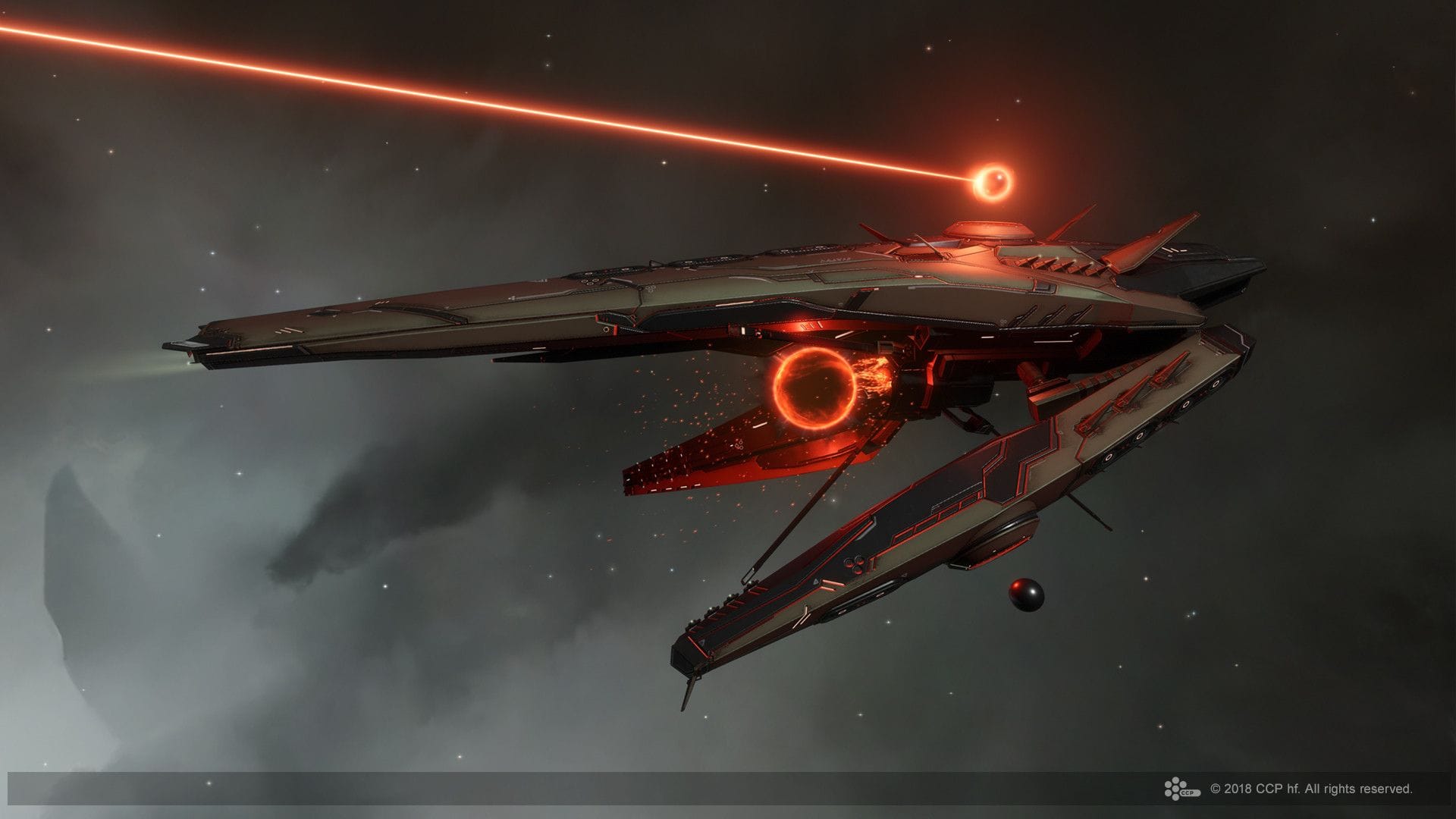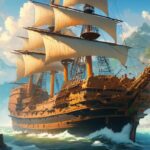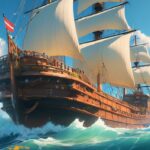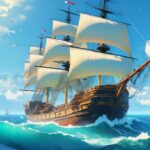Navigating the vast ocean before the advent of GPS required ingenuity, skill, and a healthy respect for the forces of nature. Sailors relied on a combination of traditional methods and innovative technologies, each with its own strengths and weaknesses. Let’s embark on a journey through the history of maritime navigation, exploring the fascinating world of pre-GPS systems.
Navigating the Open Waters: Pre-GPS Methods
Before the convenience of GPS, pinpointing a ship’s location at sea presented a significant challenge. Imagine navigating through stormy seas with no land in sight, relying on the stars or the faint hum of radio signals. These “GPS precursors” were innovative for their time and represent critical milestones in maritime history.
Celestial Navigation: Guiding by the Stars
For centuries, sailors looked to the heavens for guidance. Celestial navigation, a practice probably dating back millennia, involved meticulously observing the positions of celestial bodies—the sun, moon, stars, and planets—relative to the horizon. Using instruments like the sextant to measure angles and chronometers for precise timekeeping (essential for determining longitude), sailors could calculate their ship’s latitude and longitude. However, cloud cover could render celestial observations impossible, and even minor errors could significantly impact position accuracy.
Radio Beacons: Listening for Direction
With the advent of radio technology, new navigational possibilities emerged. Systems like LORAN (Long Range Navigation) transmitted radio signals from fixed land-based stations. By measuring the time difference between the arrival of signals from multiple stations, ships could calculate their position, unaffected by weather conditions. However, LORAN’s range was limited, and signals were susceptible to interference, potentially affecting accuracy.
Inertial Navigation Systems: Internal Guidance
Inertial Navigation Systems (INS) offered a self-contained alternative. Using gyroscopes and accelerometers to track a ship’s movement from a known starting point, INS could calculate the vessel’s current position. This proved particularly useful for submarines, which lacked access to external signals when submerged. However, INS suffered from “drift,” accumulating small errors over time that required regular recalibration using celestial observations or radio signals.
The Dawn of Satellite Navigation: Transit
The satellite age ushered in a transformative era. Transit, the first satellite navigation system, leveraged the Doppler effect—the change in a wave’s frequency as its source and observer move relative to each other—to determine a ship’s location. This marked a major leap towards the global, all-weather navigation capabilities we enjoy today.
The GPS Revolution
Finally, in the 1970s, the Global Positioning System (GPS) revolutionized navigation, offering unprecedented accuracy and reliability. GPS receivers on ships determine their position with remarkable precision, anywhere on Earth, regardless of weather, using signals from a constellation of satellites and a process called trilateration. If you’re wondering what happens if the formula in cell D49 is copied, check out this article.
Charting a Course Before GPS
Before GPS, navigating the vast oceans was a blend of skill, experience, and often, a bit of luck. Let’s delve deeper into the methods sailors employed before the era of satellite navigation.
Sailors primarily relied on celestial navigation, using the stars as their guide. By measuring the angles of celestial bodies relative to the horizon with tools like astrolabes and sextants, they could determine their latitude. Longitude, however, remained a challenge until the invention of the marine chronometer, a highly accurate clock, in the 18th century.
Dead reckoning involved estimating position based on speed, direction, and time traveled, using tools like chip logs and magnetic compasses. However, this method was susceptible to errors caused by currents, winds, and human error. Coastal navigation relied on visible landmarks, depth soundings, and local knowledge, becoming more crucial closer to shore.
Sailors also observed natural indicators like wind direction, wildlife behavior, and the presence of seaweed to gain insights into currents and proximity to land. These clues offered valuable, albeit less reliable, navigational information. Interested in learning more about the Healthsciencesforum.com team? Read this article now!
The mid-20th century saw the emergence of Loran-C, a terrestrial radio navigation system that significantly improved accuracy, especially in coastal waters. However, its range was limited, and atmospheric conditions could interfere with its signals.
Eventually, GPS revolutionized maritime navigation with its satellite-based system, providing pinpoint accuracy regardless of weather or location. It has transformed sea travel, making it safer, more efficient, and opening up new possibilities for exploration. Our understanding of ancient navigation continues to evolve through research and archaeological discoveries, suggesting that ancient civilizations may have possessed even more advanced navigational knowledge.
GPS at Sea: Modern Maritime Positioning
While we commonly refer to it as GPS, the system used on ships is often called a “marine GPS receiver,” “maritime GPS navigator,” or “shipboard GPS system.” These specialized receivers are designed to withstand the harsh maritime environment, integrating with other navigational tools like electronic chart systems and radar to provide a comprehensive navigational picture.
Marine GPS receivers are typically more robust and waterproof than standard GPS units. They offer features like external antenna connectivity for enhanced signal reception, hazard alerts, and data display tailored to maritime navigation (e.g., nautical miles, integration with nautical charts).
| Feature | Regular GPS | Marine GPS |
|---|---|---|
| Durability | Less robust | More robust, waterproof |
| Features | Basic navigation | Integrated with other tools, hazard alerts |
| Display | Typically kilometers | Nautical miles, integrated charts |
| Antenna | Internal | Often external for better reception |
While GPS has revolutionized navigation, ongoing research aims to improve its accuracy and reliability, particularly in challenging environments. Some newer systems integrate with satellite-based augmentation systems (SBAS) like WAAS, EGNOS, or MSAS for even greater precision.
Despite GPS’s dominance, prudent mariners understand its potential vulnerabilities and always combine it with traditional navigation techniques, training, and vigilance.
Unlocking the “Talk On and On” Crossword Clue
The crossword clue “Talk On and On” can be tricky, as it suggests continuous talking with various possible answers. Words like “drone,” “ramble,” “prattle,” and “jabber” fit this description, and clues may use these directly or employ more descriptive phrasing like “talk endlessly” or “go on and on.”
| Clue | Possible Answer |
|---|---|
| Talk endlessly | RAMBLE |
| Go on and on | DRONE |
| Chatter incessantly | PRATTLE |
The clue’s wording and answer length provide valuable hints. For instance, “Talk on and on” with five spaces might point to “RAMBLE,” while six spaces could suggest “DRONED.”
Crossword creators often use synonyms or related terms, adding to the challenge. Experienced solvers possess a larger vocabulary of synonyms and recognize common crossword patterns. Research suggests that experience plays a significant role in solving ability, but even seasoned solvers get stumped. The world of crosswords is always evolving, so be prepared to encounter new and unexpected clues.
While determining the exact answer requires seeing the entire puzzle, we can make educated guesses based on length, other clues, and the creator’s style. The specific answer is likely dependent on these factors. Cryptic crosswords, with their complex wordplay, are gaining popularity, potentially making clues like this even more challenging.
Ultimately, the “Talk On and On” clue highlights the interplay of language, logic, and creativity in crosswords.
- Unlock Elemental 2 Secrets: Actionable Insights Now - April 2, 2025
- Lot’s Wife’s Name: Unveiling the Mystery of Sodom’s Fall - April 2, 2025
- Photocell Sensors: A Complete Guide for Selection and Implementation - April 2, 2025

















2 thoughts on “Before GPS: Charting the Seas with LORAN and Other Navigation Systems for Ships”
Comments are closed.